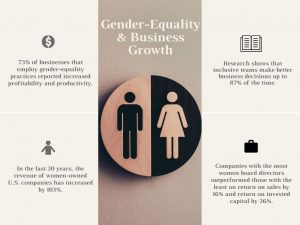It won’t come as news to anyone that focusing on gender equality in the workplace is good for women. But what might not be as obvious is how beneficial gender-equity practices can be for businesses as a whole – and not just for company culture. In fact, numbers coming out of 2021 (and prior years) have proven that gender-equality practices are just as good for a business’ bottom line as they are for creating a positive work environment. In other words, having an inclusive, supportive workplace where everyone feels valued and heard might just be the way to drive growth.
The Numbers
According to Courtney Geduldig, executive vice president, public affairs at S&P Global, “I think one of the biggest misconceptions about gender equality is that it only benefits women, but the data shows that this is not true. Our data makes it clear that gender equality is the engine for the global workforce. Greater women participation in the workforce can make a greater impact on the economy.”
The numbers don’t lie: being gender inclusive is not just a good idea in theory. Just check out the following statistics, the most recent being from 2021, which goes to show that this is something we’re still working on, and something that is very relevant to this moment, especially as women in the workforce are suffering the consequences of the pandemic more than men.
- In 2021, 73% of businesses that employ gender-equality practices reported increased profitability and productivity.
- According to McKinsey & Company, businesses with low rates of both gender and racial diversity are 29% more likely to make less money.
- If U.S. companies hired and promoted women at the same rate as countries like Norway, the economy could grow by 8%, according to S&P Global.
- In the last 20 years, the revenue of women-owned U.S. companies has increased by 103%, according to American Express.
- A 2011 Catalyst study found that companies with the most women board directors outperformed those with the least on return on sales (ROS) by 16% and return on invested capital (ROIC) by 26%.
- Research shows that inclusive teams make better business decisions up to 87% of the time, and that teams with less diversity are more likely to make poor choices for their companies.
All of these numbers, and numbers from many other studies, prove that being equitable in the workplace is good for everyone. Why? Well, beyond the simple reason that getting everyone involved in the economy is beneficial to the economy, individual workplaces that are equitable might be so profitable for reasons like the following:
- Varied viewpoints and communication skills
- A more holistic analysis of the issues a company faces
- A more positive work environment, which can stimulate productivity
- Reduced cost of turnover
- A better reputation as a business, which helps you attract higher-quality employees
What Does Gender Equality Look Like in the Workplace?
So if gender equity is the goal, before we even talk about how to get there, we need to think about what it actually looks like in the workplace. We should be working toward the following:
- Equal pay – Pay should never be based on someone’s gender (or any other characteristic, like race, religion, age, sexual orientation, etc).
- Equal treatment – Businesses need to be careful about excluding members of teams from more informal decision-making settings (like social events that only men are attending, for example), or about having different expectations of roles (like expecting a female employee to make coffee, for example).
- Equal representation on leadership teams, boards, etc – Too many businesses suffer from having “broken rungs” on their ladder, meaning women get stuck in lower-level positions and are prevented from advancing.
- Equal access to training and career-advancing opportunities – There should never be an assumption that women will eventually leave their positions, and so should not be groomed for advancement.
- Benefits focused on the needs of employees – People with families need flexibility in the workplace to keep them productive, so businesses should consider offering work-from-home options, flexible schedules, and/or PTO in place of traditional “vacation time.” Remember, too, that the availability of paid child care plays a big part in allowing parents to remain in the labor force. Every year from 2016 to 2018, more than 2 million parents of children aged 5 and younger had to quit a job, not take a job, or change their job because of child care challenges, with most of the people affected being women – and things have only gotten worse since 2020. Consider this: American businesses lose an estimated $12.7 billion annually because of their employees’ child care challenges, and the cost of lost earnings, productivity, and revenue nationally due to child care issues is estimated at $57 billion annually.
How Can We Work Towards Greater Gender Equality?
The above is what we should be working towards, but what steps can you take to get there?
Look at your recruitment practices
The first step to creating an equitable workplace is recruiting like you’re committed to an equitable workplace! That means trying things like:
- Reviewing your job advertisements to make sure they encourage everyone to apply
- Setting recruitment goals
- Widening your pool of applicants, and running campaigns in places that might attract both men and women, especially if you are looking for applicants in more stereotypically “male” careers like tech
- Making sure applicants are assessed purely on their skills, including “soft skills”
Look at your workplace environment
Hiring more women is a great start, but simply adding women and stirring is not enough. You need to look at how your workplace deals with gender issues, both in abstract and more concrete ways. Think about doing the following:
- Address the issue – If gender dynamics and issues surrounding equality feel like the elephant in the room, look that elephant right in the eye and let your employees know that you are more than open to addressing the issue and creating a plan. Make your employees feel heard and validated, and you’ll build trust.
- Redesign your workspace – Try to eliminate gender divisions at your workplace.
- Commit to equality – Offer the same rewards – whether it’s pay or otherwise – for the same work, regardless of gender.
- Consider your workers’ needs – Listening and raising awareness are important, but even more important is giving all workers what they need, including paid family leave, paid time off for childcare, flexible work arrangements, etc.
Look at your professional development strategies
Again, you need to deal with some concrete problems if you’re going to promote gender equality in your workplace; that includes making sure everyone has ways to advance or find the opportunities that are right for them. To do this, you can:
- Offer training to all employees who join your team
- Invest in individual development
- Create a mentoring program aimed at promoting women’s advancement
- Change to a less linear career structure
The problem of gender inequality is not going to just go away on its own, and it doesn’t come down to just one individual workplace – it’s a systemic issue. But fortunately we are beginning to see businesses come on board with making changes, and those changes are making a big difference in not only the lives of women workers, but also in the health of the businesses that are making these changes. We still have a long way to go, though, and you can be a part of the solution – you’ll be doing the right thing and you’ll be supporting the growth of your business!